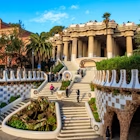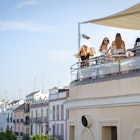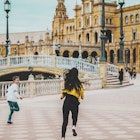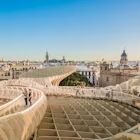
Jun 26, 2025 • 10 min read
From flamenco shows to visiting treasured historic sites, here are the best experiences unique to Seville.

Jun 26, 2025 • 10 min read
From flamenco shows to visiting treasured historic sites, here are the best experiences unique to Seville.

Mar 13, 2025 • 15 min read
These top itineraries through seductive Spain will show you the best the country has to offer.

Feb 17, 2025 • 5 min read
Where can you go for a day trip from Seville? Majestic Moorish cities, beaches, sherry country and hilltop towns are all excursions within easy reach.

Nov 19, 2024 • 6 min read
Get to know Seville’s best tapas with this guide to where to eat them, what to try and top tips on the local dining etiquette.

Aug 29, 2024 • 6 min read
From using the tram and bus networks to exploring on foot, here are our tips for getting around in Seville.

Apr 3, 2022 • 7 min read
Explore centuries of the city’s history, see a flamenco performance or take in the latest contemporary art. Here are the best free things to do in Seville.

Mar 24, 2022 • 8 min read
From cheap beer to bike hire and budget-friendly accommodation, use this guide to keep your trip to Seville affordable.

Mar 22, 2022 • 5 min read
From grand, green plazas to out-of-the-way neighborhood gems, here’s our roundup of the best parks in Seville.

Mar 18, 2022 • 6 min read
Here are the best neighborhoods to visit in Seville, from atmospheric old town barrios to traditional flamenco areas with a local vibe.

Mar 17, 2022 • 6 min read
From exploring Andalusian culture and keeping the kids entertained to touring archaeological sites, here's the ultimate guide to Seville's best museums.

Mar 15, 2022 • 5 min read
All year round, but especially in summer, the best views and vibes are at Seville’s rooftop bars. Here we reveal the sleekest, hippest and liveliest.

Apr 13, 2020 • 5 min read
Children are welcomed with warm smiles in this small, east to get around city with plenty of family-friendly activities.

Apr 3, 2020 • 4 min read
Seville is a city of architecture and cultural festivals, it's the kind of place where having a local's perspective is key to experiencing it all.

Sep 27, 2019 • 6 min read
Andalucia is Spain at its most passionate: a rugged land of medieval castles, broad beaches and Moorish-tinged cities. Here are five reasons to visit.

Aug 15, 2019 • 6 min read
Western Europe's major attractions are impressive but also draw huge crowds; the magic of exploring the big sights can be quickly lost amidst long queues…

Jul 16, 2019 • 5 min read
A compact city that you can easily discover in two days, Seville yields its multiple treasures in an unhurried way, with minimal planning necessary. Find…